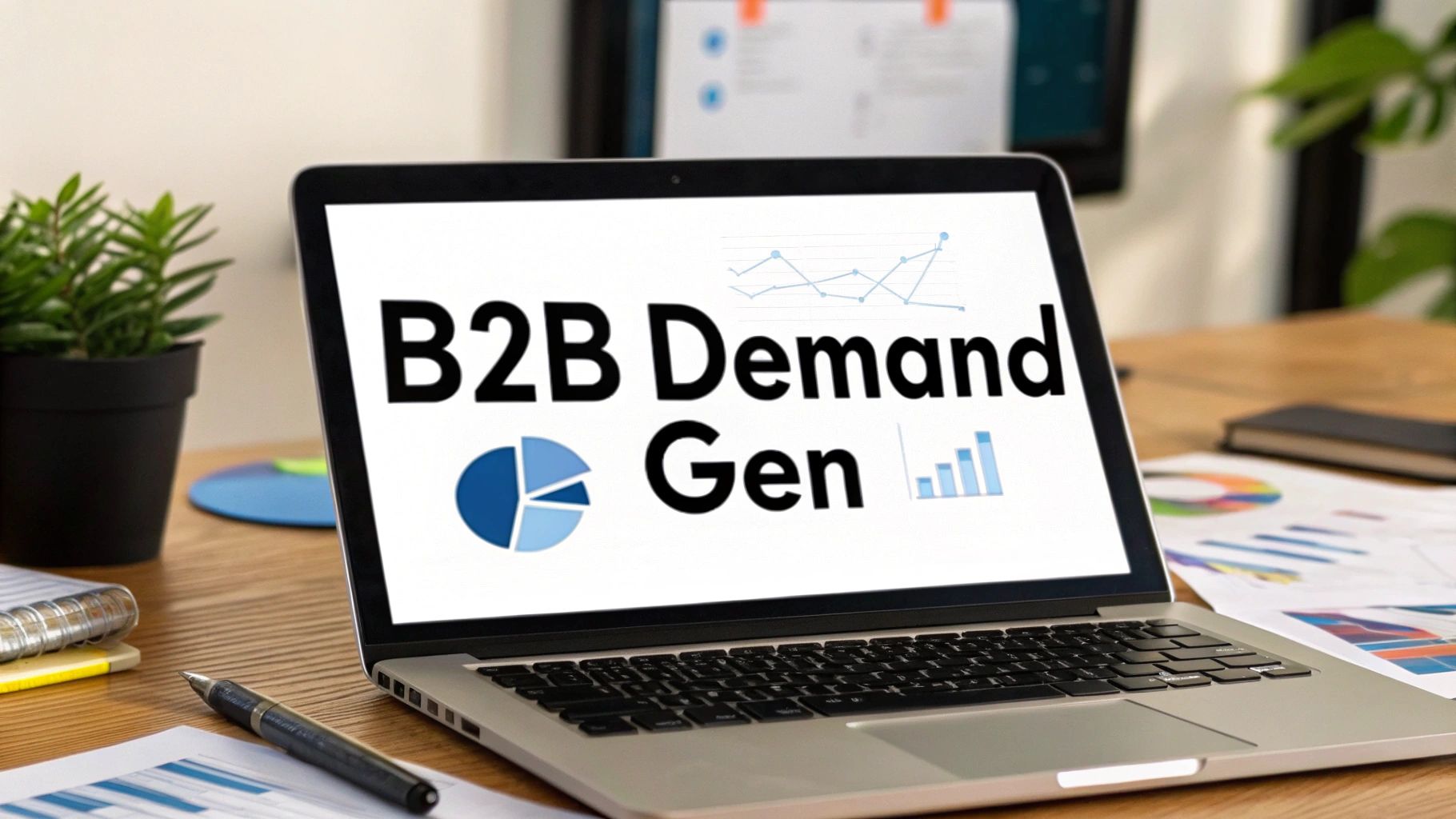In today's competitive B2B marketplace, simply generating a list of leads is a flawed metric for success. A full pipeline of unqualified names doesn't translate to revenue; it creates noise, wastes sales cycles, and ultimately stalls growth. Sustainable business expansion requires a more sophisticated approach: creating genuine demand for your solution before a prospect even considers a purchase. This means shifting focus from chasing contacts to building an ecosystem where ideal customers actively seek you out.
The core challenge for many organizations is that their marketing efforts are often a series of disconnected tactics rather than a cohesive strategy. This results in unpredictable funnels and a constant struggle to prove ROI. True growth is built on a foundation of integrated B2B demand generation strategies that attract, engage, educate, and build trust with your target audience over time. It's about becoming a go-to resource, not just another vendor.
This article cuts through the noise to provide a comprehensive roundup of 10 proven strategies that drive tangible results. We will move beyond surface-level advice and offer actionable blueprints for implementing everything from precision-targeted Account-Based Marketing (ABM) and leveraging intent data to building thriving user communities. You will learn not just what to do, but how to execute these tactics effectively to create a powerful, predictable revenue engine. Each section is designed to give you the specific insights needed to attract and convert high-value customers, transforming your marketing from a cost center into a strategic growth driver.
1. Account-Based Marketing (ABM)
Account-Based Marketing (ABM) flips the traditional demand generation funnel on its head. Instead of casting a wide net to capture as many leads as possible, ABM is a highly focused strategy where marketing and sales teams collaborate to target a select list of high-value accounts. Each target account is treated as a market of one, receiving personalized campaigns, messaging, and content tailored to their specific pain points and business objectives. This laser-focused approach ensures resources are concentrated where they will have the most significant impact, driving deeper engagement and higher-value deals.

This method is one of the most effective b2b demand generation strategies because it aligns sales and marketing efforts, improves customer lifetime value, and delivers a higher return on investment. By focusing on best-fit accounts, companies like Salesforce and Adobe (via Marketo) have successfully used ABM to land and expand major enterprise clients, proving its efficacy for complex sales cycles.
How to Implement ABM Effectively
To get started, don't try to boil the ocean. Instead, focus on a small, manageable pilot program to prove the concept and refine your process.
- Identify & Prioritize High-Value Accounts: Work with your sales team to create an Ideal Customer Profile (ICP). Use firmographic data (industry, company size, revenue) and intent data to identify 5-10 strategic accounts that perfectly match this profile and are showing buying signals.
- Deep Dive Research: For each target account, create detailed buyer personas for key decision-makers and influencers. Map out the organizational structure and understand their specific business challenges and goals.
- Create Personalized Campaigns: Develop bespoke content, ad creatives, and messaging that speak directly to the target account's needs. Coordinate multi-channel touchpoints across email, targeted social ads (like on LinkedIn), direct mail, and personalized sales outreach.
- Execute & Measure: Launch your coordinated campaign and track engagement closely. Key metrics for ABM include account engagement, pipeline velocity, and deal size, rather than just lead volume.
By treating key prospects like VIPs, ABM fosters stronger relationships from the outset. While ABM requires more upfront investment per account, its precision often leads to more substantial and sustainable revenue growth than broader tactics. To explore this concept further, you can learn more about how ABM compares to other B2B lead generation tactics and find the right mix for your business.
2. Content Marketing & Thought Leadership
Content Marketing is the engine of modern B2B demand generation, focusing on creating and distributing valuable, relevant, and consistent content to attract and retain a clearly defined audience. Rather than pitching products, this strategy provides genuine utility, educating prospects and solving their problems. Thought leadership takes this a step further by positioning your brand and its key people as the foremost experts in your industry, building the trust and credibility that are essential for high-value B2B relationships.
This approach is one of the cornerstone b2b demand generation strategies because it builds brand equity, improves organic search visibility, and nurtures leads at every stage of the funnel. By consistently providing expert insights, companies like HubSpot, with its famous blog and academy, and Drift, which defined the conversational marketing category, have built massive audiences and generated immense inbound demand without relying solely on paid advertising.
How to Implement Content & Thought Leadership Effectively
Success requires a strategic, long-term commitment, not just sporadic blog posts. Focus on creating a hub of expertise that your target audience will turn to again and again.
- Identify Content Gaps & Pillars: Analyze competitor content and use keyword research to find underserved topics. Develop comprehensive "cornerstone" content pieces (e.g., ultimate guides, original research reports) around core themes that align with your product's value proposition.
- Build Topic Clusters: From your cornerstone pieces, create a series of related articles, videos, and social posts that delve deeper into specific sub-topics. This strategy, known as topic clustering, builds topical authority and boosts your SEO performance.
- Repurpose & Distribute Widely: Don't let great content die after one post. Repurpose a single research report into a webinar, a series of blog posts, an infographic, and multiple social media clips. Distribute these assets across owned (your website, email list), earned (guest posts, PR), and paid (social ads, content syndication) channels.
- Measure & Optimize: Track key content performance metrics like organic traffic, engagement rates (time on page, shares), and, most importantly, conversions. Use clear calls-to-action (CTAs) within your content that guide readers to the next logical step in their buyer journey.
By becoming a reliable source of information, you attract qualified prospects and build a loyal audience. This strategy generates sustainable, organic growth that compounds over time. To dive deeper into this topic, you can learn more about how to develop a powerful B2B content marketing strategy that drives tangible results.
3. Marketing Automation & Lead Nurturing
Marketing Automation allows B2B companies to scale their demand generation efforts by automating repetitive marketing tasks and delivering personalized experiences to prospects at the right time. Instead of manual follow-ups, platforms like HubSpot or Marketo enable you to nurture leads through automated email sequences, score them based on engagement, and seamlessly hand off qualified prospects to sales. This process ensures no lead falls through the cracks and keeps your brand top-of-mind throughout a long and complex buying cycle.

This approach is one of the most foundational b2b demand generation strategies because it creates a scalable engine for converting interest into revenue. By segmenting audiences and triggering communications based on specific behaviors, you can guide potential customers through their journey with relevant content. Companies like Pardot (Salesforce) and ActiveCampaign have perfected this, showing how automation can build trust and educate prospects, making them more receptive to a sales conversation when the time is right.
How to Implement Marketing Automation Effectively
To avoid overwhelming your team, begin with simple, high-impact workflows and expand your automation efforts as you gain confidence and gather data on what works.
- Establish Clear Goals & Clean Data: Before you automate anything, define what you want to achieve. Ensure your CRM data is clean and segmented, as your automation platform will rely on this information to personalize campaigns.
- Develop Nurture Tracks for Personas: Don't send the same generic emails to everyone. Create distinct email nurture sequences for each of your key buyer personas, addressing their specific pain points and guiding them with tailored content like case studies, webinars, and blog posts.
- Implement Lead Scoring: Create a scoring system that assigns points to leads based on their demographic information and online behavior (e.g., visiting the pricing page, downloading an ebook). This helps sales prioritize their outreach to the most engaged and qualified leads.
- Test, Analyze, & Optimize: Continuously monitor the performance of your automated campaigns. Test different subject lines, content, and calls-to-action to see what resonates most with your audience. Regularly audit your workflows to ensure they are still effective and aligned with your goals.
By combining automation with a strategic approach to nurturing, you can efficiently manage a larger volume of leads and improve conversion rates. To dive deeper into this topic, you can learn more about implementing marketing automation best practices to build a powerful lead nurturing machine.
4. Intent Data & Predictive Analytics
Intent data and predictive analytics shift demand generation from reactive to proactive. Instead of waiting for a prospect to fill out a form, this strategy involves monitoring digital signals to identify which accounts are actively researching solutions like yours right now. Predictive analytics then uses AI to analyze this data, along with historical patterns, to forecast which leads are most likely to convert, allowing you to prioritize outreach when buying intent is at its peak. This moves your team from guessing to knowing who to target and when.

This forward-looking approach is one of the most powerful b2b demand generation strategies because it creates a significant competitive advantage by engaging prospects before they even initiate contact with competitors. Companies like 6sense and Demandbase have pioneered this space, enabling their clients to uncover "in-market" accounts from the vast "dark funnel" of anonymous research. This allows for hyper-relevant, timely engagement that dramatically increases conversion rates.
How to Implement Intent Data & Predictive Analytics
Getting started requires integrating the right data sources and aligning your sales and marketing workflows around these new insights.
- Combine Data Sources: Integrate both first-party data (website visits, content downloads) and third-party intent data from providers like Bombora or ZoomInfo. This provides a holistic view of an account's research behavior across the web, not just on your own properties.
- Integrate into Lead Scoring: Enhance your existing lead scoring models by adding intent signals as a high-value criterion. An account actively researching competitor names or relevant keywords should be scored higher and prioritized immediately.
- Trigger Timely Outreach: Set up automated alerts for your sales team when a target account shows a spike in intent. Arm them with the specific topics the account is researching to enable a highly contextual and valuable first touchpoint.
- Align with ABM Programs: Use intent data to identify and prioritize accounts for your Account-Based Marketing campaigns. Focusing your personalized efforts on accounts that are already in-market significantly boosts campaign ROI.
By leveraging these insights, you can focus finite resources on accounts with the highest probability of closing. For an in-depth understanding of how to leverage behavioral insights to identify high-potential prospects, refer to this comprehensive guide to B2B intent data. This approach ensures your message reaches the right people at the exact moment they are most receptive.
5. Webinars & Virtual Events
Webinars and virtual events are powerful, interactive online presentations that educate a target audience on specific industry topics while simultaneously generating a pipeline of qualified leads. They serve as a high-engagement platform to connect with prospects, nurture relationships, demonstrate product value in a live setting, and establish your brand as a thought leader. This format allows you to capture valuable first-party data and direct attention for an extended period, a rare commodity in today's crowded digital landscape.

This method is one of the most effective b2b demand generation strategies because it creates a direct line of communication with potential customers, offering immense value upfront. By delivering expert insights, you build trust and credibility, guiding attendees naturally toward your solution. Companies like HubSpot and ON24 have perfected the webinar model, using it not just for lead capture but as a central pillar of their content marketing and customer education efforts, proving its versatility for engaging prospects at every stage of the buyer's journey.
How to Implement Webinars & Virtual Events Effectively
To maximize your return, treat your webinar as a full-fledged marketing campaign with a clear pre-event promotion, in-event engagement, and post-event follow-up strategy.
- Choose a High-Value Topic: Select a topic that addresses a specific, urgent pain point for your Ideal Customer Profile (ICP). Use keyword research or customer feedback to find topics that resonate deeply and promise a tangible solution or learning outcome.
- Promote Extensively: Begin promoting your webinar across all channels (email, social media, paid ads, website banners) at least 2-3 weeks in advance. Create a dedicated landing page with a clear value proposition and a simple registration form.
- Design for Engagement: Keep the main presentation concise, ideally 30-45 minutes, to maintain audience attention. Incorporate interactive elements like live polls, Q&A sessions, and downloadable resources to keep attendees actively involved rather than passively watching.
- Execute a Strong Follow-Up: Send the event recording to all registrants within 24 hours. Segment your follow-up communications based on attendee engagement levels; for example, send a more sales-oriented message to those who attended live and asked questions, and a different nurture sequence for no-shows.
By providing educational content in an interactive format, webinars build a captive audience and generate leads who are genuinely interested in your expertise. To see how a top-tier company leverages this strategy, you can explore the extensive library of HubSpot's marketing webinars and learn from their best practices.
6. LinkedIn & Social Selling
LinkedIn & Social Selling have transformed B2B demand generation from cold outreach to warm, relationship-based conversations. This strategy leverages professional social platforms, primarily LinkedIn, to establish credibility, share valuable insights, and build genuine connections with potential buyers. Instead of a hard sell, social selling is about positioning your team as trusted advisors who understand the prospect's industry and challenges, making them more receptive to engagement when a need arises.
This approach is one of the most powerful b2b demand generation strategies because it meets modern buyers where they are already active and researching. By building a strong personal and company brand, you create an inbound pull effect. Companies like Salesforce and HubSpot have mastered this, with their executives and employees actively using social selling to build thought leadership and drive significant pipeline growth, demonstrating its effectiveness in a digital-first world.
How to Implement LinkedIn & Social Selling Effectively
Success on LinkedIn isn't about spamming inboxes; it's about consistently providing value and building community. Start small and focus on authentic engagement over sheer volume.
- Optimize & Build Your Profile: Treat your LinkedIn profile as a resource, not a resume. Use a professional headshot, a benefit-driven headline, and a summary that speaks to your ideal customer's pain points and how you help solve them.
- Share Valuable Content Consistently: Post 2-3 times per week, following an 80/20 rule: 80% educational, valuable content and 20% promotional. Share industry insights, case studies, and personal experiences to build authority.
- Engage Authentically: Don't just post and ghost. Respond to all comments on your posts and actively engage with content from prospects and industry leaders. Meaningful comments are more valuable than simple likes.
- Leverage Employee Advocacy: Encourage your team to share company content and their own professional insights. Employee advocacy programs amplify your reach and build trust, as messages from individuals are often perceived as more authentic than those from a corporate brand.
By focusing on helping rather than selling, social selling builds a pipeline of prospects who already know, like, and trust you. While it requires a long-term commitment, the result is a more predictable and high-quality stream of inbound interest and referrals. For those looking to dive deeper, experts like social selling pioneer Jill Rowley offer extensive resources on mastering this approach.
7. Strategic Partnerships & Channel Marketing
Strategic Partnerships & Channel Marketing is a force multiplier for demand generation. Instead of relying solely on your own marketing efforts, this strategy involves collaborating with complementary businesses, resellers, or affiliates to tap into their established audiences and credibility. This approach extends your market reach exponentially, allowing you to access warm, pre-qualified prospects through a trusted third party. The core idea is to build a symbiotic ecosystem where you and your partners mutually benefit by driving growth for each other.
This is one of the most powerful b2b demand generation strategies because it creates new revenue streams and builds a defensible moat around your business. It transforms competitors into collaborators and leverages shared resources for a common goal. Companies like HubSpot, with its vast network of solution partners and app integrations, and Salesforce, with its legendary AppExchange, have built empires by creating thriving partner ecosystems that drive immense customer value and continuous demand.
How to Implement Strategic Partnerships Effectively
Building a successful partnership program requires a structured approach focused on mutual success. Start small with a few handpicked partners to prove the model before scaling.
- Identify & Recruit Complementary Partners: Find companies whose products or services complement, but do not compete with, your own. Look for businesses that share your Ideal Customer Profile (ICP) and have a strong reputation. For example, a project management software could partner with a time-tracking tool.
- Develop a Partner Enablement Program: Don’t just sign partners and hope for the best. Equip them for success with dedicated training, marketing materials, sales collateral, and a clear point of contact. The goal is to make it incredibly easy for them to sell and market your product.
- Create Co-Marketing Playbooks: Collaborate on joint marketing initiatives like webinars, ebooks, or case studies. A playbook should outline campaign goals, target audiences, messaging, and responsibilities, ensuring both teams are aligned and the execution is seamless.
- Establish Clear Rules of Engagement: Define the process for lead sharing, registration, and attribution to prevent channel conflict. Use a Partner Relationship Management (PRM) system to track referrals and ensure partners are compensated fairly and transparently for the demand they generate.
By investing in the success of your partners, you build a powerful, scalable engine for growth. This strategy fosters deep market integration and credibility, making it a cornerstone for long-term, sustainable demand generation.
8. Search Engine Marketing (SEM) & PPC
Search Engine Marketing (SEM) is a powerful digital marketing strategy that combines organic search engine optimization (SEO) with paid advertising to increase a website's visibility in search engine results pages (SERPs). The paid component, known as Pay-Per-Click (PPC) advertising, allows B2B companies to place ads on platforms like Google and LinkedIn, targeting high-intent prospects who are actively searching for solutions. This provides an immediate and controllable stream of qualified traffic, complementing the long-term efforts of SEO.
This method is one of the most direct b2b demand generation strategies because it captures demand at its peak: the moment a potential customer is looking for a solution. By bidding on relevant keywords, you place your offering directly in their path. Companies like HubSpot and Salesforce have built significant parts of their lead generation engines on sophisticated Google Ads campaigns, proving SEM's effectiveness in reaching decision-makers at the critical point of their buying journey.
How to Implement SEM & PPC Effectively
To succeed, you need a disciplined approach that goes beyond simply bidding on keywords. A well-structured campaign is crucial for maximizing ROI and minimizing wasted ad spend.
- Start with High-Intent Keywords: Begin with branded keywords (your company or product name) and "bottom-of-funnel" keywords that signal a strong intent to buy, such as "best CRM software for small business." Use negative keywords to exclude irrelevant search terms and protect your budget.
- Structure Campaigns by Persona: Don't lump all your keywords into one campaign. Create separate campaigns and ad groups targeting different buyer personas, products, or stages of the buying cycle. This allows for highly relevant ad copy and landing pages.
- Implement Robust Conversion Tracking: You cannot optimize what you don’t measure. Ensure conversion tracking is set up correctly across all platforms to accurately attribute leads, demo requests, and sign-ups to specific keywords and ads.
- A/B Test Everything: Continuously test different ad headlines, descriptions, landing page designs, and calls-to-action (CTAs). Small optimizations can lead to significant improvements in click-through rates and conversion rates. For a detailed guide on structuring these tests, a B2B SaaS Marketing Playbook for Google Ads can provide a comprehensive framework.
While SEO builds long-term authority, PPC provides the speed and precision needed to drive immediate results. By using remarketing, you can also re-engage website visitors who didn't convert, keeping your brand top-of-mind and guiding them back into the sales funnel.
9. Case Studies & Social Proof
Case studies and social proof are powerful tools for building trust and credibility, directly addressing the skepticism inherent in B2B buying decisions. Instead of just telling prospects what your product can do, this strategy shows them. By presenting real-world evidence of customer success through detailed case studies, testimonials, reviews, and industry awards, you provide tangible proof of your value proposition. This validation helps prospects envision their own success and justifies their investment.
This is one of the most essential b2b demand generation strategies because it moves the conversation from claims to results. It shortens the sales cycle by answering key questions and overcoming objections before they are even raised. Companies like Salesforce, with its massive library of customer success stories, and HubSpot, known for its detailed, metric-rich case studies, have mastered this approach to demonstrate ROI and build an unshakeable market reputation.
How to Implement Case Studies & Social Proof Effectively
To get started, identify your happiest and most successful customers and build a repeatable process for capturing their stories. The goal is to create a diverse portfolio of proof points that resonates with different segments of your audience.
- Focus on Quantifiable Outcomes: The most compelling case studies go beyond vague praise. Work with your customers to pinpoint specific, quantifiable business outcomes. Include hard numbers like percentage increases in revenue, time saved, efficiency gains, or direct ROI figures.
- Tell a Relatable Story: Structure your case study like a story with a clear beginning, middle, and end. Outline the customer's challenge (the problem), the solution you provided (the implementation), and the results they achieved. This narrative makes the content more engaging and memorable.
- Diversify Your Formats: Not everyone wants to read a multi-page PDF. Repurpose your success stories into various formats to maximize their reach. Create short video testimonials, one-page infographics, webinar presentations, and quote graphics for social media.
- Promote Strategically: Don't let your case studies gather dust on your website. Feature them prominently on your homepage, pricing pages, and in dedicated resource centers. Arm your sales team with relevant stories to share during their outreach and use them in email nurture campaigns.
By systematically collecting and showcasing customer success, you build a powerful engine of social proof. This authenticates your marketing claims, making it easier for new prospects to trust you and ultimately choose your solution.
10. Community Building & User Groups
Community building transforms your customer base from passive users into an active, engaged network of advocates. Instead of relying solely on your own marketing efforts, this strategy fosters a space where customers can connect, share best practices, and support each other. This creates a powerful, self-sustaining ecosystem that generates organic demand through peer-to-peer recommendations, user-generated content, and powerful social proof. A thriving community acts as a moat around your business, increasing customer retention and attracting new prospects who want to be part of an active, supportive network.
This approach is one of the most sustainable b2b demand generation strategies because it builds long-term brand loyalty and reduces reliance on paid acquisition channels. Companies like Salesforce with its Trailblazer Community and Figma with its vibrant design community have proven that investing in users creates a powerful flywheel effect. Engaged members not only become better users of your product, but they also become your most authentic and effective marketers.
How to Implement Community Building Effectively
Building a community is a long-term investment, not an overnight campaign. Start by focusing on providing genuine value to a small group of core advocates and grow from there.
- Start Small & Define Your Purpose: Identify your most engaged customers and invite them to an exclusive space, like a private Slack channel or a dedicated forum. Clearly define the community's purpose: is it for product support, networking, or professional development?
- Empower Your Members: Don't make the community all about your company. Encourage members to lead discussions, share their own content, and answer each other's questions. This peer-to-peer value is the foundation of a strong community.
- Recognize & Reward Participation: Actively recognize and reward your most helpful and engaged members. This could be through a formal ambassador program, exclusive swag, early access to new features, or simply public shout-outs.
- Bridge Online & Offline: Facilitate connections by hosting a mix of virtual and in-person events, such as webinars, Q&A sessions with your product team, or local user group meetups.
By creating a sense of belonging, you turn customers into a vital part of your brand's story. A successful community doesn't just support your product; it becomes a key reason why new customers choose you over the competition.
B2B Demand Generation: 10-Strategy Comparison
Turning Your Strategy into a Scalable Demand Engine
We've explored a comprehensive suite of B2B demand generation strategies, from the hyper-focused precision of Account-Based Marketing (ABM) to the broad-reaching influence of Content Marketing and Thought Leadership. Each tactic, whether it's harnessing Intent Data, launching compelling Webinars, or mastering LinkedIn Social Selling, offers a powerful lever for growth. However, the true alchemy of demand generation isn't found in a single strategy but in their intelligent integration. The goal is not just to generate leads; it's to build a predictable, scalable revenue machine.
Your journey begins not by attempting to master all ten strategies at once, but by selecting a potent few that align with your unique business context. The path to a high-performance demand engine is paved with strategic choices, relentless execution, and continuous optimization.
Synthesizing Your Demand Generation Mix
Think of these strategies as ingredients for your unique growth recipe. The magic happens when you combine them in a way that creates a seamless and compelling buyer's journey.
For a resource-constrained startup: You might start by combining Content Marketing with Community Building. By creating valuable, problem-solving content and then engaging authentically in niche forums and user groups, you can build brand affinity and generate high-intent leads without a massive budget. This is about being smart and present where your ICP seeks answers.
For an established scale-up targeting enterprises: A powerful combination would be Account-Based Marketing, Intent Data, and Case Studies. Use intent signals to identify in-market accounts, tailor your messaging and outreach with ABM principles, and then reinforce your value proposition with compelling social proof that speaks directly to their industry challenges.
For a SaaS company aiming for market leadership: Integrating Marketing Automation with Webinars and Strategic Partnerships creates a powerful flywheel. Use partnerships to co-market and access new audiences for your virtual events, then use sophisticated automation sequences to nurture those attendees into qualified opportunities.
The key takeaway is that these B2B demand generation strategies are not isolated tactics. They are interconnected gears in a larger machine. Your content fuels your social selling, your webinars feed your nurturing sequences, and your community engagement provides invaluable insights for your entire marketing function.
From Strategy to Execution: Your Action Plan
Reading about strategy is one thing; implementing it is another. To translate this knowledge into tangible results, you must move from passive learning to active doing. Here is your immediate action plan:
- Audit & Align: Review your current marketing efforts against the ten strategies discussed. Where are your biggest gaps and opportunities? Most importantly, which 2-3 strategies offer the most direct path to engaging your Ideal Customer Profile (ICP)?
- Set Your Foundation: Before launching a new initiative, ensure your foundational elements are solid. Is your CRM clean? Is your website optimized for conversions? Is your messaging clear and compelling?
- Launch Your Pilot Program: Choose one high-impact strategy to pilot for the next 90 days. For instance, if you choose Content Marketing, commit to publishing four high-value blog posts and one downloadable guide. Define what success looks like with clear KPIs, such as a 15% increase in organic traffic or 50 new MQLs.
- Measure, Iterate, Scale: This is the most critical step. Relentlessly track your pilot program's performance. What worked? What didn't? Use these learnings to refine your approach. Once you have a proven, repeatable process, you can confidently invest more resources to scale it.
Mastering these B2B demand generation strategies is about more than just hitting a quota. It's about building a sustainable competitive advantage. By creating a system that consistently attracts, engages, and converts your ideal customers, you transform marketing from a cost center into the primary engine of your company's growth.
Ready to amplify your presence in the communities where your ideal SaaS customers are actively seeking solutions? PimpMySaaS specializes in authentic community engagement and forum marketing, helping you get discovered in relevant discussions on platforms like Reddit and Quora. Let us help you turn organic conversations into a powerful and scalable demand generation channel.
